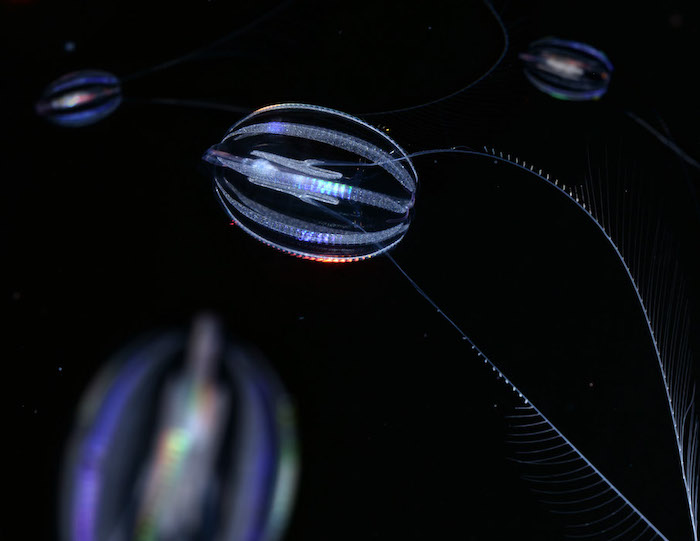Scientists generated a karyotype, chromosome-scale genome assembly, and manual genome annotation for a common ctenophore.
Ctenophores—beautiful marine invertebrates also known as “comb jellies”—have long fascinated and perplexed biologists. Phylogeneticists believe that either ctenophores or sponges were the first organisms to branch off from the tree of life, making them the “sister clade” to all other animals. However, debate is ongoing about which group can claim this title.
A study published in G3: Genes|Genomes|Genetics provides researchers with new tools to address these questions. The paper describes the first-ever published ctenophore karyotype and the first full annotated genome assembly for Hormiphora californensis, a small, globular ctenophore that is found off the shores of California and elsewhere in the Pacific Ocean.
The chromosome-scale H. californensis genome will allow whole-genome comparisons that weren’t possible with previous assemblies, says lead author Darrin Schultz. “The applications go beyond studying ctenophores—we can compare this genome to that of any other species to look for differences and understand more about the history of evolution.”
Going Over the Genome with a Fine-Toothed Comb
Schultz and his fellow researchers started with karyotyping, using a simple DNA staining protocol on ctenophore embryos to determine that H. californensis has 13 chromosomes. Then, after successfully isolating DNA samples suitable for long-read sequencing—a feat in and of itself—the team used PacBio Iso-Seq and Illumina RNA-seq technologies to sequence and annotate the full 110-Mb genome, manually determining at high resolution how genes were arranged on each chromosome.
“We spent hundreds of hours going through the entire genome by hand and making sure that every single gene annotation was correct,” says Schultz. “We did this because we saw evidence that previous ctenophore genome assemblies contained incorrect fusions or splits in genes. We wanted it to be right this time.”
As the researchers sifted through the genome, they found that H. californensis has an unusually high degree of heterozygosity—up to eight or nine percent in some areas of the genome. This presented bioinformatic challenges.
“The copies of the genome from the maternal side and the paternal side are so different from each other that it was like I had to assemble two separate genomes and try to come up with one assembly to represent both of those unions at the same time,” says Schultz.
As they got further into the annotation process, the team realized that two to three percent of the protein-coding genes occur completely within the bounds of another gene—not just one inside another, but multiple genes nested like Russian dolls. This architectural quirk has been observed in other species, especially eukaryotes with smaller genomes, but scientists are not yet sure whether the transposition processes that likely cause this “nesting” have any implications for the overall biology of an organism.
Comparative and Evolutionary Studies in Store
The new annotated ctenophore genome assembly will likely be used for comparative studies to address the phylogenetic “sister clade” debate between ctenophores and sponges in the coming years. Other applications of this study include addressing even broader questions about life on Earth. Some researchers are studying the genetic underpinnings of symbiosis using marine models like corals, ctenophores, and other cnidarians that have symbiotic algae. Others are interested in using comparative genomic studies to examine the evolution of specific traits that separate animals from all other organisms.
“This genome is just another step toward understanding how neurons and muscle cells—these things that made all of us uniquely animals—evolved over 600 million years ago,” says Schultz.
Schultz also notes that H. californensis may eventually be able to become a model species. It has a short life cycle, clear embryos ideal for developmental observation, and is more easily maintained in culture than many other related organisms. And now, it has a complete annotated genome available for study.
CITATION:
A chromosome-scale genome assembly and karyotype of the ctenophore Hormiphora californensis
Darrin T Schultz, Warren R Francis, Jakob D McBroome, Lynne M Christianson, Steven H D Haddock, Richard E Green
G3 Genes|Genomes|Genetics 2021: jkab302
https://doi.org/10.1093/g3journal/jkab302































